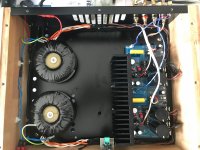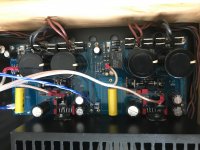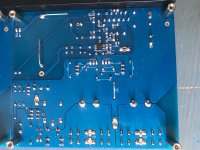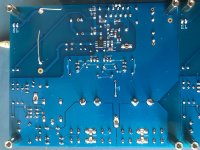Check R11.
Yes wanted to say the same
Hello Mark and Joseph,
Thank you very much! R11 was open.
You brightened up my evening!


Rugged design
The design is tough. Grounds, feedback loops, heatsink selection mistakes have never prevented proper recovery. The relay should save the speaker also.Hello Mark and Joseph,
Thank you very much! R11 was open.
You brightened up my evening!

Slightly Off Topic
I am thinking about taking my primary system FE from its wooden board (lots of experiments) and putting it into a proper enclosure. The quotes above got me thinking about EMI filters. Some people on these forums strongly believe in EMI filters. Others, like George above, prefer not to use them.
What are your reasons for using or not using EMI filters? Are there times when it makes sense? I am not looking to create an ugly argument here, just trying to understand the choice.
My reason for considering it is that I live near the end of a mains power branch and my mains power is somewhat dirty. I see noise on the mains from DC to as high as my scope can measure (~10 MHz). An EMI filter won't do anything about DC, but I'm curious about the rest.
Jac
Last question: in my amp I use an IEC with EMI filter, it's OK or should EMI filter avoided in power amp like my_ref?
No EMI filter, ti prego..
I am thinking about taking my primary system FE from its wooden board (lots of experiments) and putting it into a proper enclosure. The quotes above got me thinking about EMI filters. Some people on these forums strongly believe in EMI filters. Others, like George above, prefer not to use them.
What are your reasons for using or not using EMI filters? Are there times when it makes sense? I am not looking to create an ugly argument here, just trying to understand the choice.
My reason for considering it is that I live near the end of a mains power branch and my mains power is somewhat dirty. I see noise on the mains from DC to as high as my scope can measure (~10 MHz). An EMI filter won't do anything about DC, but I'm curious about the rest.
Jac
I use these on all my builds with no ill effect.
Apexjr.com
untitled
http://www.apexjr.com/images/APEXJREMIFILTER1.jpg
Apexjr.com
untitled
http://www.apexjr.com/images/APEXJREMIFILTER1.jpg
Last edited:
Thanks to Troy and anyone else taking time to read my post. After thinking about it, this system uses a surge protector with mild linear high frequency filtering. So I really don't need to add a second EMI filter. And I didn't hear any degradation when I added the surge protector, so I don't think I am losing anything.
Jac
Jac
Hi Guys,
here is another builder of My_ref looking for advices.
After power on, relays click and LED is on (1,25A fuse tend to blow most of the times so I went up to 2.5A).
TAs are two Toroidy 25+25V 200VA.
After some hours of burn in, DC offset is around 40mV on one channel and 5mV on the other. After 10 min. the first channel goes down to less than 20mV. DC offset reading is the same both with inputs shorted and open.
Voltage readings on both boards are correct, generally slightly lower than those marked on the boards.
R11 is OK, not open.
PGND not connected yet, boards floating.
The problem? I have no sound at all. If I twiddle with the inputs I can hear crackles.
here is another builder of My_ref looking for advices.
After power on, relays click and LED is on (1,25A fuse tend to blow most of the times so I went up to 2.5A).
TAs are two Toroidy 25+25V 200VA.
After some hours of burn in, DC offset is around 40mV on one channel and 5mV on the other. After 10 min. the first channel goes down to less than 20mV. DC offset reading is the same both with inputs shorted and open.
Voltage readings on both boards are correct, generally slightly lower than those marked on the boards.
R11 is OK, not open.
PGND not connected yet, boards floating.
The problem? I have no sound at all. If I twiddle with the inputs I can hear crackles.
Attachments
The pictures show a tidy build. The offset and relay indicate the issue is front end related.
The offset would not be correct if it was LM3886 or feedback loop related.
I recommend you check continuities and resistance values between the input around the LM318. I suspect an open and that is why the signal is not getting through.
Shorting the input should make a small difference unless there is an open or short already.
Sorry for the delay.
Btw, assume you have clipped the leads on the input cap.
I use a transformer instead of the input capacitor. The capacitor does not have to be there, try connecting the signal to both sides of the input cap to see if this helps your troubleshooting.
The offset would not be correct if it was LM3886 or feedback loop related.
I recommend you check continuities and resistance values between the input around the LM318. I suspect an open and that is why the signal is not getting through.
Shorting the input should make a small difference unless there is an open or short already.
Sorry for the delay.
Btw, assume you have clipped the leads on the input cap.
I use a transformer instead of the input capacitor. The capacitor does not have to be there, try connecting the signal to both sides of the input cap to see if this helps your troubleshooting.
Argh.. This confirm I'm stupid enough... I connected the input cap exactly to the pad marked with "signal ground" where a writing on the board warns not to connect the cap there....
Thanks Panelhead, you opened my eyes!
Now I have a very nice sound.. and some optimization work ahead to do.
Thanks Panelhead, you opened my eyes!
Now I have a very nice sound.. and some optimization work ahead to do.
Thanks Dario..finally a bottom response from a LM3886
So I just finished the ver 1.72 My_Ref Fremen + Evo A mod build using the Mouser BOM (except I used the four recommended Mundorf 10000 uF/63V caps (I had them sitting around from other Gainclone builds). I’m driving Genesis Physics model 210 speakers (8 ohm) with a Dacmagic 100 DAC. All the other LM3886 or LM3875 builds I’ve tried have wonderful presence and amazing sound but lack a good bottom response. Dario’s variation of Mauro Penasa’s original design is amazing! The soundstage AND the bottom response is there and I’m only using a single Antek AS-3222 transformer. It’s a bit bright but I guess I’ll have to buy the cost-is-no-object upgrade components and see what they yield. Thanks Dario!
So I just finished the ver 1.72 My_Ref Fremen + Evo A mod build using the Mouser BOM (except I used the four recommended Mundorf 10000 uF/63V caps (I had them sitting around from other Gainclone builds). I’m driving Genesis Physics model 210 speakers (8 ohm) with a Dacmagic 100 DAC. All the other LM3886 or LM3875 builds I’ve tried have wonderful presence and amazing sound but lack a good bottom response. Dario’s variation of Mauro Penasa’s original design is amazing! The soundstage AND the bottom response is there and I’m only using a single Antek AS-3222 transformer. It’s a bit bright but I guess I’ll have to buy the cost-is-no-object upgrade components and see what they yield. Thanks Dario!
The Mouser parts are not your problem. Look elsewhere in the system.
I am only familiar with the Fremen in your system. Seems the one I built has great high frequency response. Tried it with several speakers and it was good with all tried. Even a pair of Thiel CS-3.5 which are a little hot on top.
I am only familiar with the Fremen in your system. Seems the one I built has great high frequency response. Tried it with several speakers and it was good with all tried. Even a pair of Thiel CS-3.5 which are a little hot on top.
"The Mouser parts are not your problem. Look elsewhere in the system"
Panelhead, You were correct. I switched to a different DAC unit and responses were more what I expected. I’ll still try the Elna Cerafine cap at C9 instead of the Nichicon since Dario emphasized that as a strongly suggested upgrade.
Panelhead, You were correct. I switched to a different DAC unit and responses were more what I expected. I’ll still try the Elna Cerafine cap at C9 instead of the Nichicon since Dario emphasized that as a strongly suggested upgrade.
The Evo A Mod builds do respond to tweaking. But are fine with generic parts.
The original designer was a cheap part guy. DIP general purpose bridge rectifiers, zener regulated low voltage rails, low end MF resistors. His later projects evolved to better spec parts.
He felt circuit design, layout, and operating points were 99%.
The original designer was a cheap part guy. DIP general purpose bridge rectifiers, zener regulated low voltage rails, low end MF resistors. His later projects evolved to better spec parts.
He felt circuit design, layout, and operating points were 99%.
After a year of use I wanted to confirm all the good qualities of this amplifier. But I wanted to ask for some advice.
I am first and foremost a musicophile. I listen to every musical genre, I have over 15,000 titles. I don't only listen to audiophile recordings.
Many regular recordings, and unfortunately almost all today's commercial music productions, are annoying in long plays.
For me My_Ref is quite pleasant even with such recordings. But, for example, in C9 I found Silmic better than Cerafine or KZ. KZ and even more Cerafine are very rich in detail, perhaps they sound better with audiophile records.
For my tastes and my needs I preferred Silmic for the body, the musical timbre and what for me is the ease of listening (I imagine Dario disagrees, I hope he will forgive me!...).
All the rest of my stereo system goes in this direction: turntables and cartridges settings, R-2R ladder dac NOS, passive tvc preamp, geometry in self-built solid core cables, crossover in self-built sealed box 3-way loudspeakers, every choice was made in the direction of ease and sweetness. At the risk of giving up a bit of the so-called detail.
My version of this amplifier is the Evo A mod, industrial bom with the Amtrans caps and Mundorf Supreme in C13. I use two 160VA transformers.
I ask those who have more experience than me if they have changes to suggest to go even further in the direction of my idea of musicality, made of body and warmth, which further removes the risk of harshness in music reproduction.
Thank you all
Invia commenti
Cronologia
Salvate
Community
I am first and foremost a musicophile. I listen to every musical genre, I have over 15,000 titles. I don't only listen to audiophile recordings.
Many regular recordings, and unfortunately almost all today's commercial music productions, are annoying in long plays.
For me My_Ref is quite pleasant even with such recordings. But, for example, in C9 I found Silmic better than Cerafine or KZ. KZ and even more Cerafine are very rich in detail, perhaps they sound better with audiophile records.
For my tastes and my needs I preferred Silmic for the body, the musical timbre and what for me is the ease of listening (I imagine Dario disagrees, I hope he will forgive me!...).
All the rest of my stereo system goes in this direction: turntables and cartridges settings, R-2R ladder dac NOS, passive tvc preamp, geometry in self-built solid core cables, crossover in self-built sealed box 3-way loudspeakers, every choice was made in the direction of ease and sweetness. At the risk of giving up a bit of the so-called detail.
My version of this amplifier is the Evo A mod, industrial bom with the Amtrans caps and Mundorf Supreme in C13. I use two 160VA transformers.
I ask those who have more experience than me if they have changes to suggest to go even further in the direction of my idea of musicality, made of body and warmth, which further removes the risk of harshness in music reproduction.
Thank you all
Invia commenti
Cronologia
Salvate
Community
Glad you're enjoying your amps. This design responds very well to component changes, and you should be able to get exactly the sound you want from it.
After having built dozens of versions of the MyRef in various configurations, I will say that the worst I ever heard it sound was with a Silmic at C9. Sucked all the life and energy out of the music. But I understand how taste and systems can vary, so, knowing your preferences, let me suggest you try a carbon film resistor at R10. For a while, the BOM called for a Riken there, and I tried it, and it did exactly what you are asking for. To me, it sounded pretty dull, but it did add body to the midrange.
Another suggestion is a different cap at C13. Mundorf caps are well known to add a bit of emphasis to the high frequencies, which a lot of people perceive as extra detail. Clarity Caps are much smoother, to the point that I don't care for them, but, again, it might be exactly what you're looking for.
Peace,
Tom E
After having built dozens of versions of the MyRef in various configurations, I will say that the worst I ever heard it sound was with a Silmic at C9. Sucked all the life and energy out of the music. But I understand how taste and systems can vary, so, knowing your preferences, let me suggest you try a carbon film resistor at R10. For a while, the BOM called for a Riken there, and I tried it, and it did exactly what you are asking for. To me, it sounded pretty dull, but it did add body to the midrange.
Another suggestion is a different cap at C13. Mundorf caps are well known to add a bit of emphasis to the high frequencies, which a lot of people perceive as extra detail. Clarity Caps are much smoother, to the point that I don't care for them, but, again, it might be exactly what you're looking for.
Peace,
Tom E
Giacinto,
I agree with Tom that this am is very responsive to component choices and that C9 and C13 are excellent places to tune the sound to your preference. I would also add that they seem to interact. For example, at one point I tried a Blackgate NX at C9 with a Mundorf Supreme Silver Oil at C13. Both of these are very detailed sounding caps and the combination was too much for my system.
Regarding choices that will show a bit more warmth and musicality, the Blackgate PK is available and adds a bit of warmth. I haven't compared it to the Silmic, but the PK's are pretty cheap, so might be worth a try.
There is a cap combination at C13 that I think sounds very musical, but Dario considers colored sound. That is a Russian K75-10 (1 uF, 250V preferred) parallel with a 1nF Amtrans AMCH or similar small cap. Feel free to play with the size and type of the small bypass cap, I did. The K75-10 is found on ebay. Mine are the green ones.
Enjoy the process.
Jac
I agree with Tom that this am is very responsive to component choices and that C9 and C13 are excellent places to tune the sound to your preference. I would also add that they seem to interact. For example, at one point I tried a Blackgate NX at C9 with a Mundorf Supreme Silver Oil at C13. Both of these are very detailed sounding caps and the combination was too much for my system.
Regarding choices that will show a bit more warmth and musicality, the Blackgate PK is available and adds a bit of warmth. I haven't compared it to the Silmic, but the PK's are pretty cheap, so might be worth a try.
There is a cap combination at C13 that I think sounds very musical, but Dario considers colored sound. That is a Russian K75-10 (1 uF, 250V preferred) parallel with a 1nF Amtrans AMCH or similar small cap. Feel free to play with the size and type of the small bypass cap, I did. The K75-10 is found on ebay. Mine are the green ones.
Enjoy the process.
Jac
- Home
- Amplifiers
- Chip Amps
- My_Ref Fremen Edition - Build thread and tutorial



